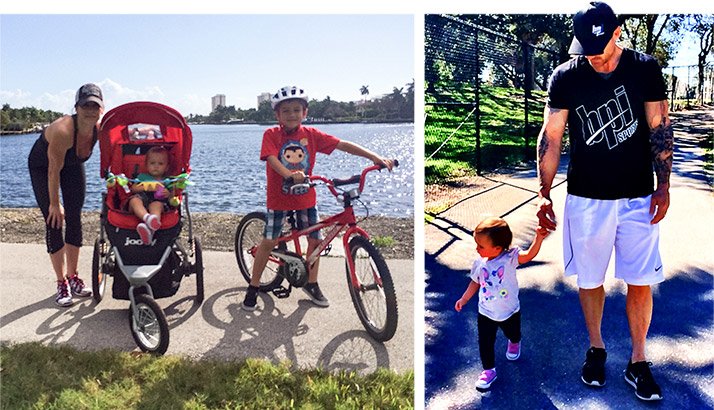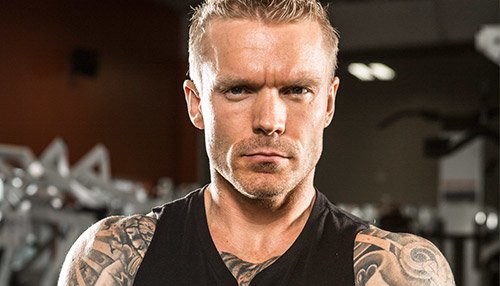
Family And Fitness: How James Grage Combines The Two
You don't have to choose between family time and time in the gym. Learn how to strike a healthy balance with these tips.
When it comes to reasons for missing the gym, family often floats to the top of the list. Think for a moment about the conversations you've had with friends or co-workers about fitness. When trying to rationalize why they can't find the time to train, and recounting all the commitments they have, family tends to play a key role. They might say they don't want to take quality time away from their spouse or kids to focus on themselves, and that they can't be that selfish. What they need to know is that focusing on fitness won't hurt—and will likely even improve—connections with their loved ones.
Need proof? Look no further than James Grage, co-founder of BPI Sports. With a wife, two kids, and an ever-growing business, he can't be as mono-focused on training as he was in his 20s, but that doesn't mean he can't train at all. They key is learning how to strike a balance between training, nutrition, fitness, and the rest of your life. It's not as easy as it sounds.
"I see a lot of people who have similar obligations really struggle when it comes to finding a balance," says Grage. "They feel like ultimately something suffers. But it doesn't have to. Fitness isn't just something we do in our house—it's our way of life."
Wanting to devote as much time as possible to your family is admirable, but don't use it as an excuse to relish in your unhealthy ways. Commit to fitness, get your family involved, and lead by example. Not sure where to start? Follow these Grage-approved steps.
Reframe Your Mindset
Before you make any physical changes, you need to change your mindset. If you keep thinking your moves toward a healthier, fitness-focused lifestyle are a burden to your family, you'll undoubtedly fall off the wagon. No one wants to better themselves at another's expense—especially not at the expense of loved ones. Remind yourself that that's not what you're doing. You're creating a healthy change for everyone. Get excited. Making healthy habits something fun that everyone can enjoy is crucial to the success and longevity of your new lifestyle. It's not an obligation; it's an opportunity.

Make Meal Prep Fun
Meal prep doesn't have to mean hours slaving over a stove and filling up Tupperware by your lonesome. Make meal prep a family affair, and get everyone involved. When you cook meals at home, explain the importance of a balanced diet to your children.
Make sure you have as many healthy options as possible available on hand, and limit the sugary cereals and candy bars that might line your pantry and fridge—for example, trade in those brownie bites for pre-cut celery and peanut butter or air-popped popcorn. This will help you realize that clean eating is a lifestyle choice, not a short-term sacrifice. "My wife and I don't diet," says Grage. "That's just a horrible word that sets people up for failure and makes all of your life-long changes sound like a short-term remedy. Instead, we just eat healthy and take care of ourselves."

Even when he's really dialing in is nutrition for a shoot, James doesn't resort to dieting. Instead, he just thinks of it as another stage of discipline in his eating. This way, he avoids the all-too-common yo-yo dieting. "Year round I eat well, and even at 40 I'm always no more than 4 weeks out from photo-shoot shape," Grage explains. "When I'm done with the shoot, I don't 'fall off a cliff' with my program—I just go back to my maintenance plan."
What helps him maintain his lifestyle? Family support. "The great thing about it is my whole family eats this way," he says. "My meals don't isolate me—they bring us all together. This way, I'm also teaching my kids healthy eating habits that last a lifetime. That's when habits start, when you're young."
Exercise Together
While you don't want your children positioning themselves under the squat rack or hanging around the heavy weights, it's still possible to teach them about the importance of exercise on a regular basis. Grage always finds ways to include the most important people in his life in what he feels is the most important part of his day: his training time.
In addition to being a way to blow off stress and reinvigorate your body, exercise can be a powerful bond between you and your children. It is for James. "My 7-year-old son loves doing jumping jacks and push-ups with me," he says. "I've never forced it on him. He wants to do it because in our house we make fitness fun. That's the key to making anybody want to do anything. Make it enjoyable."

Not sure how to get your children involved? Follow these tips to get them tuned in at any age:
Pre-school: Nothing's more motivating than your tot cheering you on. Young children can serve as motivational coaches whether you're pushing them in their stroller around the track, or they're stretching alongside you during your post-workout cool-down. Don't be afraid to teach them basic bodyweight exercises such as push-ups, sit-ups, jumping jacks, bodyweight squats. Take advantage of any daycare services your gym offers and talk to your little ones about why it's so important for mom and dad to be in shape. They'll feel more involved and excited to be a part of your commitment to a healthy lifestyle.
Elementary School: Once your children are a bit older, they'll be able to take on an even more active role in your fitness journey. Have them run with you for a few minutes or perform a few basic exercises or—if they're bitten by the fitness bug—consider running sprints. End the day with stretching, deep breathing, and maybe a walk for a few minutes to cool down. Your encouragement and example might even pique their interest in team sports where they'll learn about fitness, commitment, and sportsmanship.
Middle and High School: If your children are a bit older, consider taking them to the gym with you. Different gyms have different policies, but many allow teenagers to attend if accompanied by a parent. This is an opportunity to work one-on-one with your child and teach them a bit on proper form, setting goals, and possibly incorporating their training into helping them perform better at team sports. Consider setting up a rewards program to help them reach certain goals. The benefits could be greater than you realize—even positively affecting their schoolwork. According to a report by The Institute of Medicine, children who are more active have greater attention span and perform better on standardized testing than their less-active peers.
Perhaps more importantly, these changes will stick with them later on down the road. "My kids may or may not continue a health and fitness lifestyle when they're older, but they'll know the difference between good and bad lifestyle choices," says James. "From there they can choose, but I believe it'll be an easy choice for them. They don't feel like they are missing out or deprived. As a family, we still have our indulgences. We'll go get ice cream on the weekend or order the occasional pizza.
"At the end of the day, when it comes to getting my family excited to go do something physical, I never have to twist their arm or bribe them. They are always ready to do it. That's the environment that my wife and I have created."


